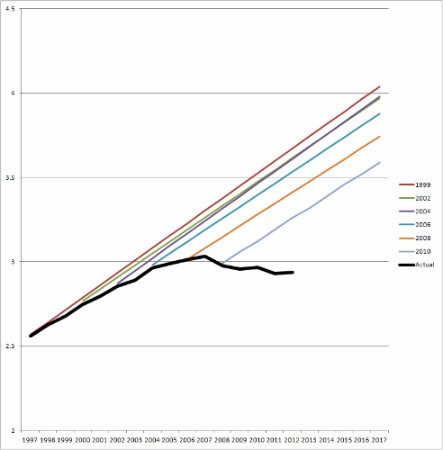Government projections of driving rates continue tradition of wrongness
The government is fairly shoddy at predicting the habits of American drivers, according to studies recently reported by The Atlantic. And the government’s repeated over-projections of American miles driven may exert a direct impact on infrastructure and transportation policy – and budgets – for years to come.
According to The Atlantic’s Emily Badger, by now, commonly held wisdom that states American car use hit a peak around 2006. In short, the car peak describes how Americans drove “more collective miles” yearly than they had in the prior year. This consistent rise was predictable, until the middle of the last decade, when the country’s Vehicle Miles Traveled (VMT) reached a peak of 3 trillion miles yearly before dropping, writes Badger. The VMT number has remained roughly level since.
But the government’s predictions for VMT hasn’t fallen — in fact, it continues to climb.
Data from from Eric Sundquist at the State Smart Transportation Initiative (a University of Wisconsin-based group that promotes environmentally sustainable transportation and government transparency) and Tony Dutzik at The Frontier Group (a think tank working for a “cleaner environment and a fairer and more democratic society”) shows a contrast between America’s true VMT with the government’s projections spanning the last decade.

This chart shows each year’s projections for U.S. vehicle miles traveled (in trillions) vs. the actual VMT statistics. The difference means waste on a massive scale. From SSTI.
The government data used in the chart hails from a yearly U.S. Department of Transportation “Conditions and Performance” report, delivered to Congress; the Department of Transportation calculates these estimates using traffic data from local agencies.
The government’s predictions and the actual total of miles vary greatly, but what is perhaps most troubling is how frequently the government’s calculations were off. Another issue: the predictions “aren’t wobbling off course years after they were first produced (no one expects a prognosticator to perfectly predict what will happen 10 or 20 years from now),” writes Badger. In actuality, the predictions have emerged as “grossly inaccurate” — sometimes as early as mere months after their publication.
Why does it matter? The government’s — faulty — projections influence infrastructure budgets. Continued mis-judgements of America’s VMT will have a direct impact on funding for transportation projects and infrastructure decisionmaking.
Dutzik and Sundquist analyzed at 61 yearly predictions from the Department of Transportation reports, only to discover that every one of them has proven to be too high. One example, writes Sundquist, is “the 1999 C&P overshot 2012 reported VMT by more that 22 percent — almost 11 extra states’ worth of driving.” That’s a drastic difference.
In a 2013 interview with The Atlantic, Dutzik explained the significance of reliable VMT information. “We’ve basically assumed in transportation planning for decades upon decades that the amount of vehicle travel and per capita VMT can go in only one direction, and that’s up… And we have been planning our transportation system based on that assumption.”
What’s at stake? If we continue to experience stagnating car driving rates, the country’s highway needs will change significantly in the near future, and the expenditures citizens require will be quite different from what the government’s predictions would suggest.
Without reliable government projections, transportation budgets and transportation needs have little chance of alignment.
Category: Infrastructure, Trends















